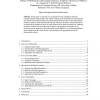454 search results - page 13 / 91 » On the existence of difference sets in groups of order 96 |
BMCBI
2005
13 years 7 months ago
2005
Background: High throughput methods of the genome era produce vast amounts of data in the form of gene lists. These lists are large and difficult to interpret without advanced com...
ICNP
2002
IEEE
14 years 11 days ago
2002
IEEE
We consider several distributed collaborative key agreement protocols for dynamic peer groups. This problem has several important characteristics which make it different from trad...
CORR
2008
Springer
13 years 7 months ago
2008
Springer
In this paper we describe a new approach to data modelling called the concept-oriented model (CoM). This model is based on the formalism of nested ordered sets which uses inclusion...
KDD
2010
ACM
13 years 11 months ago
2010
ACM
An ensemble is a set of learned models that make decisions collectively. Although an ensemble is usually more accurate than a single learner, existing ensemble methods often tend ...
DATAMINE
2006
13 years 7 months ago
2006
Least trimmed squares (LTS) regression is based on the subset of h cases (out of n) whose least squares t possesses the smallest sum of squared residuals. The coverage h may be se...

